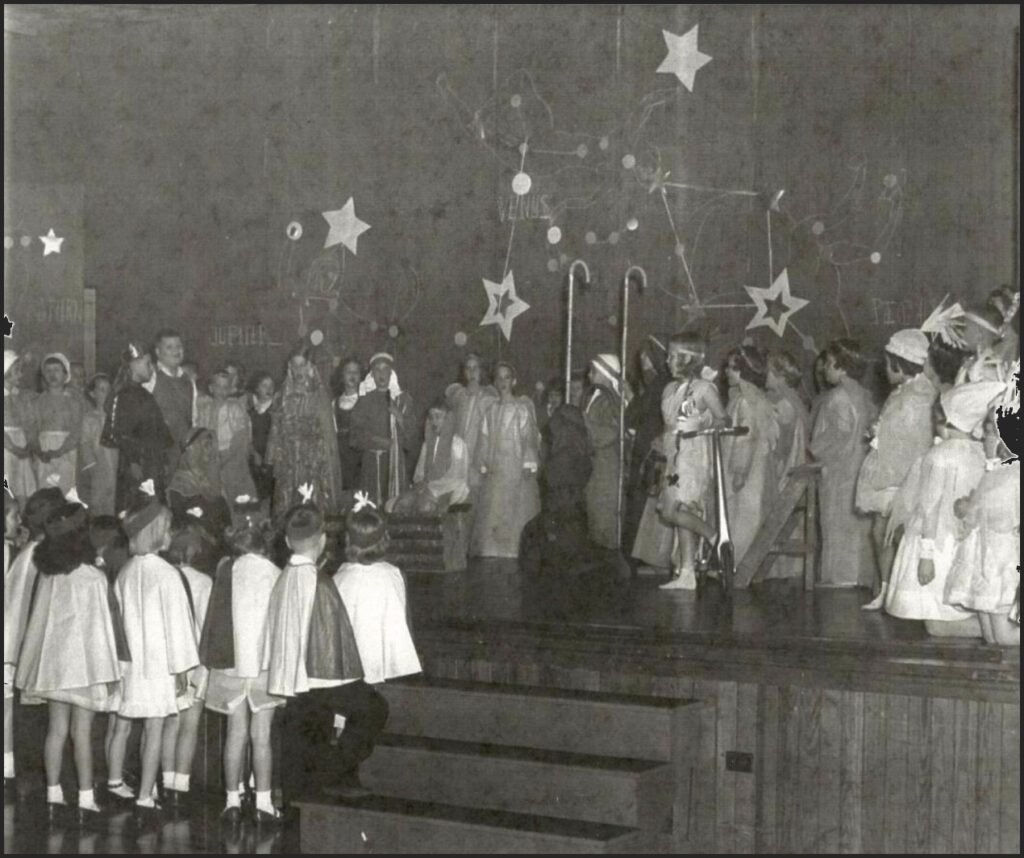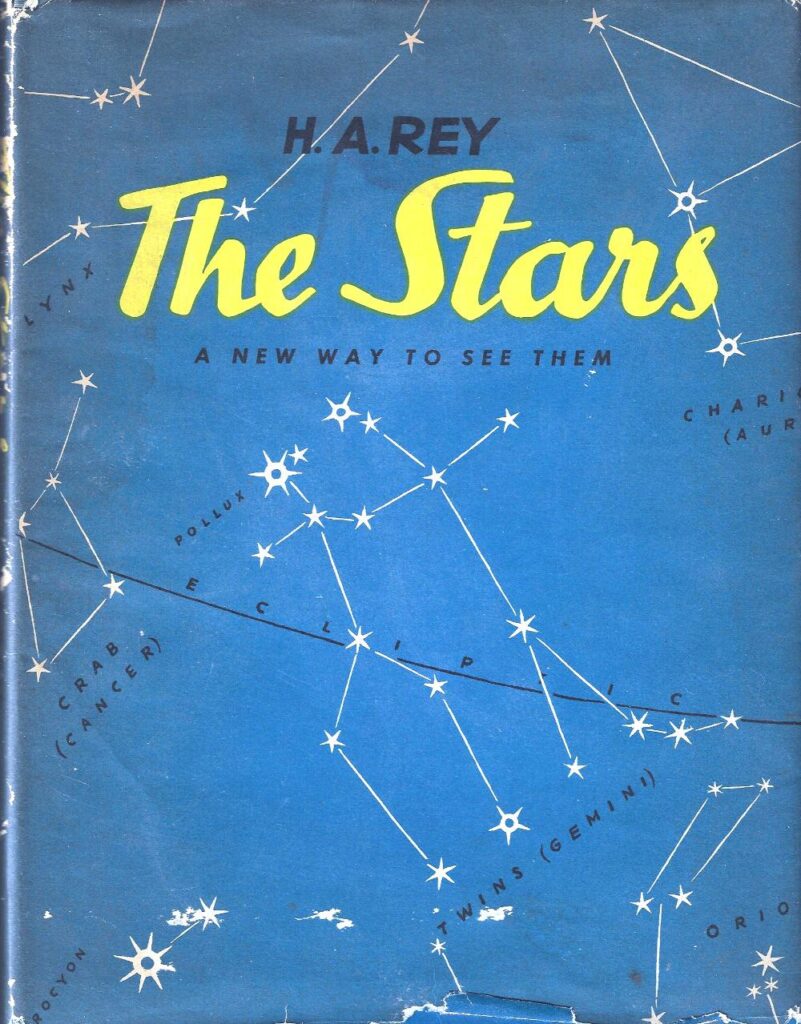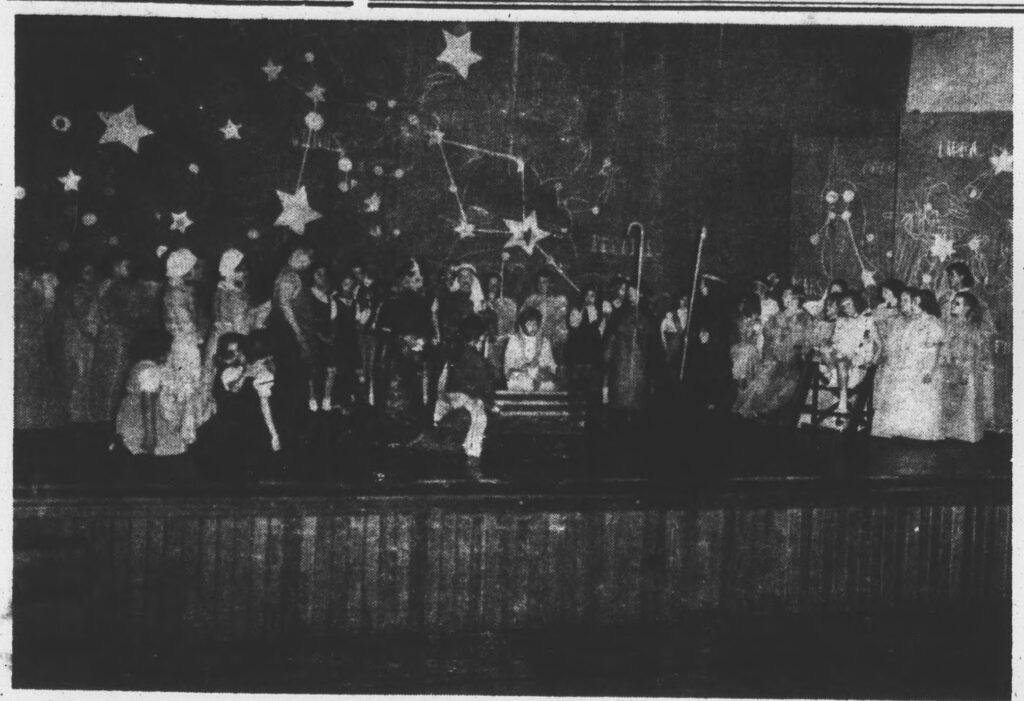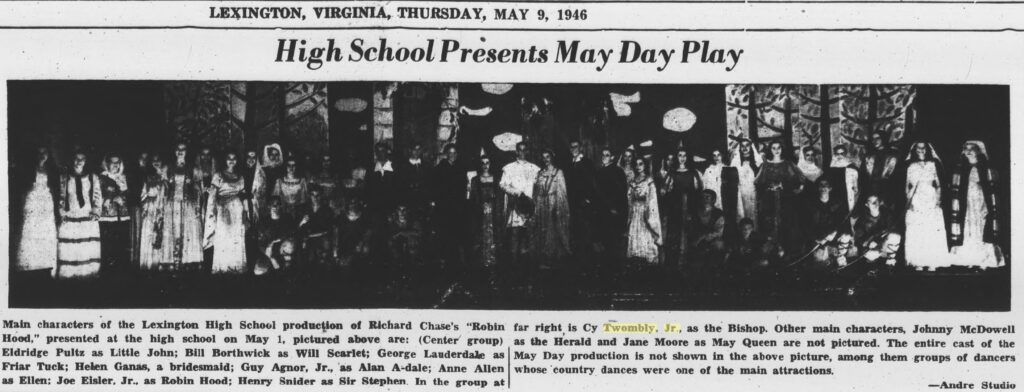
There is not a lot of time to get into this right now, but holy smokes, Cy Twombly painted the backdrop for the local elementary school’s Christmas play in 1953, and no one’s said boo about it except for one intrepid art history undergraduate.
In 2014, the interest of Washington & Lee art history student Sarah I. Nexsen was piqued by an archival photo in Lexington, Virginia’s local newspaper, The News-Gazette. It showed the December 1953 production of The Comet, a Christmas-themed play written by the Rev. Thomas V. Barrett, for the Ann Smith Elementary School. The backdrop was credited to local boy Cy Twombly, and that was all anyone wrote. The backdrop had never been mentioned in Twombly literature. Nexsen wrote about it for her senior thesis, titled, “The Land of the Stars: The Origin of Cy Twombly’s Aesthetic.” An ambitious project, to be sure.
Near as Nexsen can tell, Twombly got the gig while on leave from the Army, over the Christmas break. Twombly’s former art teacher attended the church where Barrett, the playwright, presided.
According to Nexsen’s research, which included interviewing the star of the show herself, The Comet tells the Nativity story from the point of view of a comet which becomes the Star of Bethlehem. But first it travels through The Land of Stars, meeting planets, raindrops, and Mary & Joseph along the way. Twombly’s backdrop depicts this Land of Stars.
The backdrop was in three panels; the largest, in the center, was approximately 7 x 12 feet wide. The stage right panel, showing Saturn, is partially visible in the only known photo; the stage left panel depicting Mars and Neptune is not documented. Nexsen says the backdrop was discarded and destroyed after The Comet‘s single performance on December 19.
We all owe this young scholar a great debt for bringing this massive, lost, early work to light, and for conducting vital, on-the-ground research to learn its history before the march of time robbed us of its witnesses. So let’s just say that it would indeed be amazing if this lost painting proved to be the momentous source for Twombly’s entire practice: his combination of text and graphic; his classical sourcing; his giant scale; his Lexington influences. 1953 was in the middle of Twombly’s emergence: after he and Rauschenberg ran off to Italy together, and showed at Stable Gallery together, and before he moved back to New York, and then on to Italy.
So it could totally be! But I am going to say it’s unlikely. And Twombly’s own apparent jettisoning of this work and any information about it into a black hole means the case is that much harder to make.
And anyway, rather than depicting Roman gods and their symbolic meanings, it seems more likely that Twombly’s painting of The Land of Stars shows stars, constellations, and planets. If I had the time–when I get the time–I feel like it would be possible to locate the star chart or vintage astronomical map that Twombly used as a source.

The constellation diagrams in my instant guess, The Stars: A New Way To See Them, the immediately popular, influential, and accessible beginner astronomy guide by H.A. Rey, the creator of Curious George, which was published in 1952, don’t really match. But whenever I get to recreating this destroyed Twombly, the deep blue night skies of Rey’s book will be as much inspo as the artist’s own blackboard paintings.

[January 2025 UPDATE:]
With Twombly’s youthful paintings on the blog again, I took occasion to research his earliest days in Lexington, and found another, broader photo of Twombly’s 1953 backdrop for The Comet. It was on the front page of the Rockbridge County News.

Rockbridge County News
He also painted at least two other theater backdrops while a student at Lexington High School, in 1945 and 1946. The first, for Gilbert & Sullivan’s “The Mikado,” was executed by Twombly, but designed by a sergeant at the School for Personnel Services, the wartime training facility that was (and would be) Washington & Lee University. As Japanese satire or caricature, “The Mikado” was considered suitable wartime entertainment. No photos of this production have surfaced.

Rockbridge County News on May 9, 1956
In 1946, though, Twombly designed and executed an entire Sherwood Forest for the school production of “Robin Hood.” And he played the Bishop. He’s the tall one stage left. Images of his prize-winning paintings and sculptures he showed in Richmond as a high school student have also not surfaced.
Meanwhile, art historian Katherine Markoski recently published a close look of Twombly’s “actual” [sic] artmaking from this period, focused on paintings he made during his formative studies at Black Mountain College in 1951.
Nexsen’s 2014 Thesis, “The Land of the Stars: The Origin of Cy Twombly’s Aesthetic” is online [wlu.edu via Tom Cheetham’s Twombliana collection]
Previously, related: Jasper Johns Blue Ceiling by Matson Jones?
